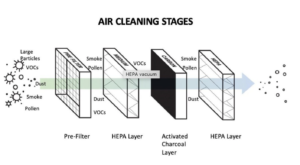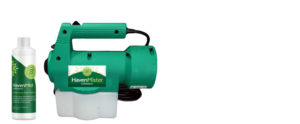Your HEPA Vacuum and Air Purifier Can Become Your Best Friends!

The Critical Importance of Removing Microscopic Mold Debris After Cleaning or Fogging
By Cesar Collado
Mold exists everywhere! If you are allergic to mold or have a genetic predisposition where your body may not be able to identify and remove mold antigens from your system, removing mold spores from your environment becomes essential to getting well. Approximately 25% of the population have the HLA-DR genetic defect that causes the sensitivity.
Fogging your home is often necessary to reduce the mold counts in the air you breathe. This is accomplished by hot fogging or cold fogging (misting) with a non-toxic, natural, and safe product that can be aerosolized and dispersed in microscopic particles that can fill the air and reach mold spores everywhere in your home. The size of these particles can range from 5-30 microns, similar in size to mold spores. The fog will address mold spores floating in the air and on surfaces. It will be able to reach corners, crevices, and blind objects leaving nothing untouched.
After fogging or misting, dead mold spores are likely to drop to the floors, furnishing, and surfaces due to the weight of the air droplets. The next important step is to remove the mold spore debris and any secondary metabolites (mycotoxins) by wet mopping/wiping hard surfaces and vacuuming carpets and fabric goods with a HEPA vacuum.
HEPA History
The original HEPA filter was designed in the 1940s and was used in the Manhattan Project to prevent the spread of airborne radioactive contaminants. It was commercialized in the 1950s, and the original term became a registered trademark and later a generic term for highly efficient filters. Today’s filters have government standards that ensure HEPA filters remove 99.97% of particulates of 3 microns or more. A “micron” is an abbreviated term for “micrometer”, or a millionth of a meter (1/1,000,000 meters). A human hair is about 75 microns across (depending on the person). Bacteria can be between about .2 microns and 3 microns in size.
During the 1950s and beyond, HEPA filters were commercialized to provide air filtration used in applications that require contamination control or “clean rooms”, such as the manufacturing of disk drives, medical devices, semiconductors, nuclear, food and pharmaceutical products, as well as in hospitals,[8] *Should this reference be linked in the article?*homes and vehicles. Hospitals utilize HEPA for sanitation reasons. Airplanes have adopted the use of HEPA filters to remove infectious pathogens from the circulating air in an airplane to aid in preventing the spread of infections.
HEPA Vacuums
High-Efficiency Particulate Air (“HEPA” ) vacuums have powerful suction that pulls the vacuumed particles through a HEPA filter designed to trap bacteria, mold, and viruses in addition to dust, dander, pollen, dust mites, etc. in order to capture these microscopic elements.
When fogging, the cell walls of mold spores remain in the room. HEPA vacuums are most often closed cannister vacuums with carpet, floor, and upholstery tools in order to be able to vacuum more than just floors. Surfaces, home furnishings, and all upholstered items can be vacuumed easily to remove harmful particulates.
The best vacuums have both a pre filter and a HEPA filter that is enclosed. Regular vacuums remove dust and objects with a much simpler filter system where smaller particulates are blown out and redistributed in the environment. As a result, HEPA vacuums are more densely filled and are heavier. Proper care and containment is necessary to change filters by avoiding exposure to antigens captured in the filter.
While the best HEPA cannister vacuums can be pricey ($400- 1000), there is a cost effective alternative. You can purchase regular, old school vacuums that accommodate HEPA filter bags. For less than $140, you can buy such a vacuum. Please make sure they use HEPA bio-bags. You will be amazed at the number of bags you will fill, even with a previously vacuumed carpet.
Carpets can weigh up to 8 times their installed weight when removed. This is due to the abundance of microscopic particles that get captured in carpet fibers.


Finally, there are “HEPA” vacuums that are bagless. For allergy or mold sufferers, these are not recommended because patients can experience a significant exposure to antigens when emptying the compartments.
HEPA Air Purifiers
Portable HEPA air purifiers are often recommended by physicians to keep running in rooms where you spend the most time. These are usually reliable and be maintained by changing HEPA filters periodically. They are very effective filtering the air in a single room regularly over time.
Heating, Ventilation, Air Conditioning (HVAC) systems can be equipped with whole house HEPA filters that will filter all the air as it is conditioned in your HVAC system. This is not inexpensive; however, it can provide peace of mind for mold sensitive people. Practically, professionals have recommend the use of MERV-11 rated filters in normal HVAC systems, which are not as efficient as HEPA filters, but do increase particle removal over normally installed HVAC filters. MERV-11 filters can be purchased at your local home improvement store and are fairly easily identified, as the packaging typically states that they remove allergens and mold spores.
Air purifiers do not replace the need to identify the source of moisture and mold and fix it, nor do they replace HEPA Vacuuming.
IQ Air Austin Air


Bio-Balance Hot Fogging Solutions
Haven Fogger (up to 4000 sq. ft.) Haven Mini Fogger (up to 700 sq. ft.)


These solutions will reach all areas of the home including corners and crevices to reduce the fungal air count dramatically, down to close to zero. These packages do not replace identifying the source of mold, removing it, and fixing it when possible! To earn more about Bio-Balance DIY Fogging solutions, click HERE.
- Fogging rooms with the Bio-Balance Fog Kit (for <750 sq. ft.)
- Fogging the entire home with Bio-Balance Deluxe Package (for <3000 sq. ft)
Bio-Balance Cold Fogging Solutions
Maintenance misting using a cold fogging solution that aerosolizes Bio-Balance Maintenance Misting Solution diluted with distilled water is a quick and easy way to treat regularly to reduce fungal concentrations in the air and on the surfaces of the home.
- The Bio-Balance Home Maintenance Mister is an inexpensive way to spot fog rooms, furniture, carpets, cars, and closets. This fogger weighs less than 5 lb. so you can ably reach all areas including cabinets and above furnishings to fog your home.

- The Bio-Max Commercial Maintenance Mister can be used for large homes or regular maintenance fogging of commercial spaces. This fogger weighs less than 10 lb. and comes with a shoulder harness to carry the weight, with a delivery hose to allow for agile fogging throughout the area to be treated like the smaller fogger.

© 2020, Cesar Collado, All Rights Reserved


 Since the majority of mold is inhaled, the largest concentration of mycotoxins exists in the sinus mucosal tissue. Currently, there are no diagnostics to test for mycotoxins in the sinuses. Because the sinuses reside adjacent to the cerebral spinal fluid around the brain, direct exposure to the brain can cause significant neurological symptoms without being detected in a urine test for mycotoxins. I know of few cases where ENTs have removed damaged tissue from the sinuses during surgery and have tested that tissue for mycotoxins after the procedure (similar to a cancer biopsy). This is NOT the norm for most ENTs I have encountered, though. In fact, I only know of one who has embraced this practice. Most ENTs refer patients with neurological symptoms to a neurologist.
Since the majority of mold is inhaled, the largest concentration of mycotoxins exists in the sinus mucosal tissue. Currently, there are no diagnostics to test for mycotoxins in the sinuses. Because the sinuses reside adjacent to the cerebral spinal fluid around the brain, direct exposure to the brain can cause significant neurological symptoms without being detected in a urine test for mycotoxins. I know of few cases where ENTs have removed damaged tissue from the sinuses during surgery and have tested that tissue for mycotoxins after the procedure (similar to a cancer biopsy). This is NOT the norm for most ENTs I have encountered, though. In fact, I only know of one who has embraced this practice. Most ENTs refer patients with neurological symptoms to a neurologist. It is a significant challenge to even find ENTs who treat fungal sinusitis other than surgical removal of “fungal balls.” I receive numerous accounts of patients seeing ENTs for mold without success or frustrated with the outcome. It is also rare for an ENT or any specific specialist to treat the body in an integrative manner. This is no fault of theirs as the specialty that they are licensed to practice is very focused. The burden to find such doctors falls on the patients.
It is a significant challenge to even find ENTs who treat fungal sinusitis other than surgical removal of “fungal balls.” I receive numerous accounts of patients seeing ENTs for mold without success or frustrated with the outcome. It is also rare for an ENT or any specific specialist to treat the body in an integrative manner. This is no fault of theirs as the specialty that they are licensed to practice is very focused. The burden to find such doctors falls on the patients.